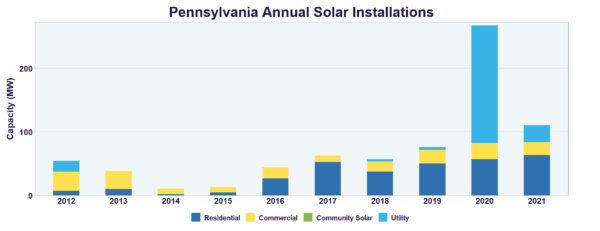A group of First Energy affiliated utilities have released a request for proposals (RFP), aiming to procure 20 MW of solar and associated credits via power purchase agreements. Pennsylvania Power Company (Penn Power), Pennsylvania Electric Company (Penelec), West Penn Power Company (West Penn) and Metropolitan Edison Company (Met-Ed) are actively seeking proposals.
Eligible bids will be structured as power purchase agreements (PPA) ranging from four to ten years, with a capacity up to 20 MW. The proposal includes a request for both the electricity produced, and the associated Solar Photovoltaic Alternative Energy Credits (SPAECs).
Pre-qualification deadline for the RFP is Monday, November 7, 2022. Notification of pre-qualification will follow on November 14, 2022. The proposal due date is December 5, 2022. The RFP process is managed by The Brattle Group.
Solar in Pennsylvania
The Solar Energy Industries Association (SEIA) reports that Pennsylvania has just under 1 GW of solar cumulatively installed through Q2 2022. SEIA projects that the state may add another 1.9 GW over the next five years alone.

Scott Elias, director of state affairs, mid-Atlantic for SEIA said that increasing the carve out under the Alternative Energy Portfolio Standard (APS) standard will send a demand signal to boost solar in the state. The requirement set back in 2004 was .5%, which has been exceeded. SEIA is aiming to push it to 2% or 2.5% by 2030. “We want to make sure that Pennsylvania is not less valuable for development than neighboring states,” said Elias.
As for residential adoption of solar in Pennsylvania, a positive note is that the state has no cap on net metering. In 2007, the Pennsylvania Public Utilities Commission (PUC) expanded the net-metering rules, which approved the use of third-party ownership models. Furthermore, utilities must provide the same rates to net-metered customers as non-net metered, and they may not charge any fees that do not apply to other customers.
Net-metered customers are credited for excess generation at the full kilowatt-hour rate, which includes generation, transmission and distribution changes. Meter aggregation is allowed on properties owned or leased by the customer, which can benefit commercial entities that may have multiple buildings with separate meters that fall under the same account. Virtual net meter aggregation is also allowed.
This content is protected by copyright and may not be reused. If you want to cooperate with us and would like to reuse some of our content, please contact: editors@pv-magazine.com.









By submitting this form you agree to pv magazine using your data for the purposes of publishing your comment.
Your personal data will only be disclosed or otherwise transmitted to third parties for the purposes of spam filtering or if this is necessary for technical maintenance of the website. Any other transfer to third parties will not take place unless this is justified on the basis of applicable data protection regulations or if pv magazine is legally obliged to do so.
You may revoke this consent at any time with effect for the future, in which case your personal data will be deleted immediately. Otherwise, your data will be deleted if pv magazine has processed your request or the purpose of data storage is fulfilled.
Further information on data privacy can be found in our Data Protection Policy.